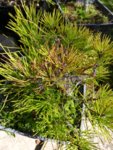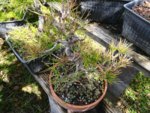TommyHallahan
Yamadori
I believe this pine I have (not exactly sure species) has Dothistroma, or some type of needle spot. I only just noticed it, so symptoms appearing in the last week or so. I read that copper fungicides should be applied just before new needles emerge, and through the growing season periodically...
Is there anything I can do starting now to help it out?
Should I apply fungicides now anyway?
Should I remove needles that are showing signs of infection? Or just wait til they fall off?
Any input will be greatly appreciated
Is there anything I can do starting now to help it out?
Should I apply fungicides now anyway?
Should I remove needles that are showing signs of infection? Or just wait til they fall off?
Any input will be greatly appreciated






